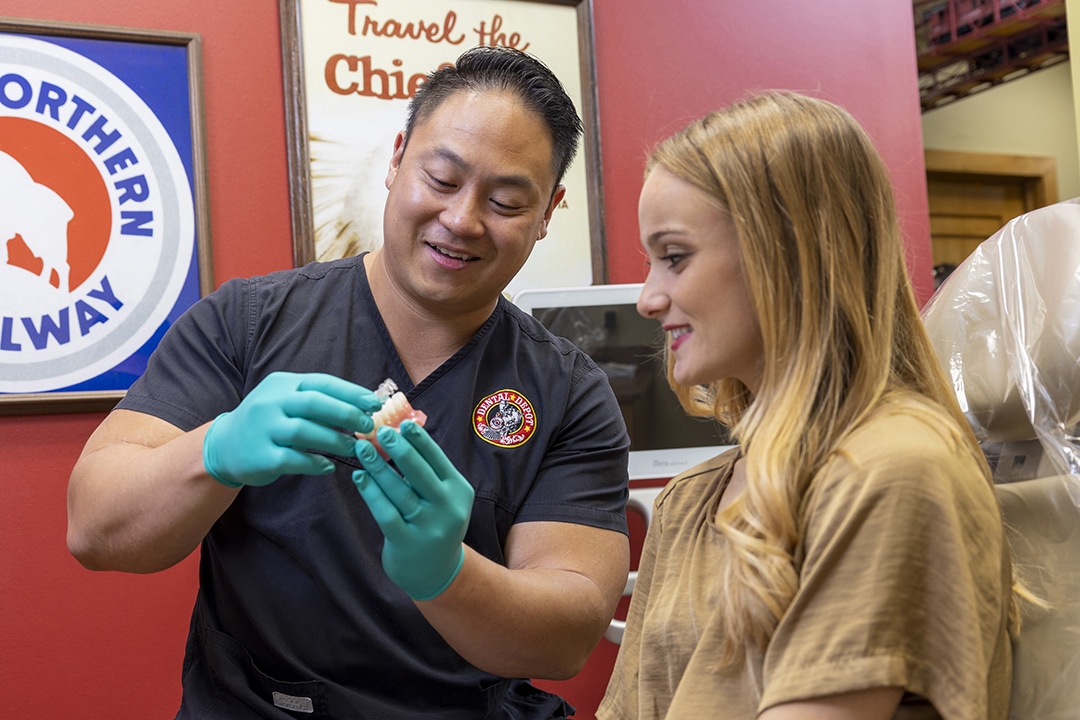Schedule Orthodontic Consultation
Braces, Invisalign, Retainers
Braces, Invisalign, Retainers
All forms of orthodontic treatment use the same physiological process of moving teeth and jaws into proper occlusion, or alignment of the top and bottom teeth. This is achieved by the gradual use of gentle pressure to reshape bone and gum tissue and guide new bone growth into the desired position. Treatments generally fall into two categories, braces—which use non-removable metal brackets and wires to move teeth—and aligners like Invisalign —removable trays that slowly guide teeth into place.

Traditional metal braces use stainless steel wire and brackets to adjust teeth positioning with gentle, constant pressure. Brackets are attached to teeth using an adhesive, then metal alloy wire threaded through slots in the brackets and held in place by tiny rubber bands called o-rings or ligatures.
The wire slotted through the brackets is called an archwire. The wire is tightened and adjusted to control movement. Round wires are used in earlier stages of treatment while rectangular archwires are used in later stages to refine teeth movement. If more force is necessary on a tooth or segment of teeth, rubber bands called elastics are hooked onto the tiny “wings” of the metal brackets and used to apply additional pressure than wires alone.
Ceramic braces are nearly identical to metal braces, except they use tooth-colored brackets made of ceramic or porcelain instead of stainless steel. This makes ceramic braces virtually invisible.
Instead of ligatures, self-ligating braces are aligned using a door mechanism. Because the braces slide along the wire instead of being held in place by rubber bands, teeth can move more freely with less discomfort and force. Self-ligating braces cause less friction between the wire and braces and are generally easier to maintain and care for. Without the need to replace rubber bands, appointment times can also be extended to 8-12 weeks.
Dental Depot offers the Damon Clear system, a version of self-ligating braces with clear, nearly invisible brackets. Damon braces feature polycrystalline alumina (PCA) material that resists stains from acidic food and drinks, and the advanced passive self-ligating technology applies lighter pressure without the need for elastics for more efficient tooth movement.
Invisalign® is a brand of clear aligners. Clear aligners use a series of removable custom-made plastic trays to apply pressure to teeth. Your orthodontist will use a 3D computer image of your teeth to create a treatment plan, then each alignment tray is created individually to help gradually guide teeth into the desired placement. The clear, thin trays are changed out every two weeks or so to move teeth a fraction of a millimeter at a time.
Clear aligners can be removed for eating and oral hygiene, but otherwise should be worn for at least 23 hours a day. Patients are responsible for wearing and changing out the aligners as recommended, and the number of aligners will depend on the severity of the misalignment as well as adherence to orthodontic guidance.
Dental Depot is a certified Invisalign® provider.
The wire slotted through the brackets is called an archwire. The wire is tightened and adjusted to control movement. Round wires are used in earlier stages of treatment while rectangular archwires are used in later stages to refine teeth movement. If more force is necessary on a tooth or segment of teeth, rubber bands called elastics are hooked onto the tiny “wings” of the metal brackets and used to apply additional pressure than wires alone.
Regardless of your treatment method, your orthodontist will most likely recommend a removable or fixed retainer after your treatment to maintain your results. Removable retainers are made of a thin, clear, and slightly flexible plastic that is custom-fitted to your teeth. Fixed retainers are thin wires that are permanently adhered to the back of the teeth. Both types of retainers serve to hold teeth in their new positions, allowing the newly reshaped bone to harden around the teeth.
Dental Depot is more than routine dental cleanings; we care for your smile at every stage of your life. In addition to our dedicated team of dentists and dental hygienists, we are also proud to provide an AAO-certified orthodontist at our Oklahoma City metro orthodontic locations.
For more information on your orthodontic treatment options, or to schedule a complimentary consultation with one of our orthodontists, visit our website at dentaldepot.net/find-location to find an office near you.
